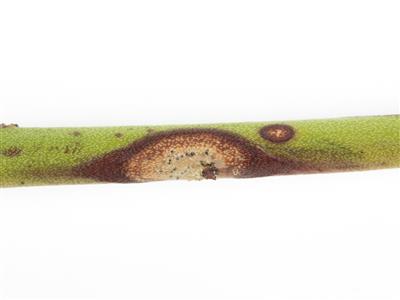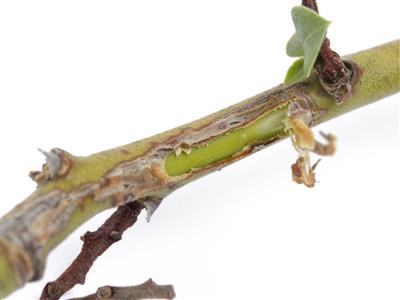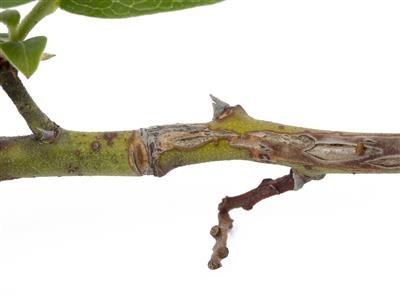
Cancros
WHAT IS AND HOW TO ELIMINATE
Canker Or Stem Canker
Fussicocum Putrefaciens
Pathogen:
Fungus
Type:
Risk to the plant:
HIGH



DESCRIPTION
WHO CAUSES IT?
Fusicoccum putrefaciens is a pathogenic fungus that mainly affects blueberry plants, causing the disease known as canker or stem canker. This fungus can survive in plant debris and soil for long periods, especially in high humidity conditions. The spores of the fungus are released and dispersed mainly by water and wind. When spores come into contact with a host plant, they germinate and penetrate tissues through wounds or natural openings, such as stomata. The fungus grows and develops within the plant tissues, causing necrosis and canker formation on the stems and branches. During favorable weather conditions, the fungus produces reproductive structures on the cankers, which release new spores that can infect other nearby plants, thus perpetuating the infection.
SYMPTOMS
In blueberries, Fusicoccum putrefaciens causes the disease known as canker or stem canker, which can have a significant impact on plant health and productivity. The disease manifests itself mainly in the stems and branches, where the fungus invades the tissues and causes a series of symptoms that affect the growth and development of the plant. Symptoms can include the appearance of necrotic lesions and cankers on branches and stems, which can eventually lead to dieback of parts of the plant.
- Necrotic lesions on stems and branches.
- Cankers or chancres that form around the lesions.
- Detachment of the bark in the affected areas.
- Withering and drying of shoots and branches.
- Regressive death of branches, starting from the tips.
- Reduction in fruit production and deterioration in quality.
- Appearance of reproductive structures of the fungus in cankers.
- General weakening of the plant and decrease in its vigor.


TEMPERATURE AND HUMIDITY
15°C - 25°C
80% - 90%

HOW IS IT SPREAD?
Wind, irrigation water, direct contact between plants, contaminated growing tools, infected plant remains

HOW TO REMOVE IT?
Home remedies
There are no home treatments
Chemical treatments
• ORANGE OIL 6% [SL] P/V
• SULFUR 70% [SC] P/V
• SULFUR 80% [SC] P/V
• SULFUR 80% [WG] P/P
• EUGENOL 3.3% + GERANIOL 6.6% + THYMOL 6.6% [CS] P/V
• COPPER OXYCHLORIDE 35% (exp. in Cu) [WG] P/P
• PIRACLOSTROBIN 6.7% + BOSCALIDE 26.7% (I) [WG] P/P
• CUPROCALCIC SULFATE 12.4% (EXPR. IN CU) [SC] P/V
Authorized treatments in organic farming
• ORANGE OIL 6% [SL] P/V
• SULFUR 70% [SC] P/V
• SULFUR 80% [SC] P/V
• SULFUR 80% [WG] P/P
• EUGENOL 3.3% + GERANIOL 6.6% + THYMOL 6.6% [CS] P/V
• COPPER OXYCHLORIDE 35% (exp. in Cu) [WG] P/P
• CUPROCALCIC SULFATE 12.4% (EXPR. IN CU) [SC] P/V
Insect allies
EFFECTIVE PRODUCTS TO ELIMINATE THIS PEST
Sponsored link
Sponsored link
Sponsored link
Sponsored link
Sponsored link
Sponsored link
Effective against all types of fungi
- Carry out sanitary pruning to eliminate and destroy infected parts of the plants.
- Avoid wounds on plants during cultivation work, since these are entry doors for the fungus.
- Ensure good soil drainage to avoid the accumulation of excessive moisture.
- Apply preventive fungicides during periods of highest risk, such as spring and fall.
- Maintain good ventilation between plants to reduce humidity and improve air circulation.
- Disinfect pruning and cultivation tools after each use to prevent the spread of the fungus.
- Implement crop rotation and avoid continuous planting of blueberries in the same place.
- Regularly monitor plants to detect early symptoms and act in a timely manner.
- Avoid sprinkler irrigation, which can favor the spread of fungal spores.
- Use blueberry varieties that are more resistant to stem canker.




















